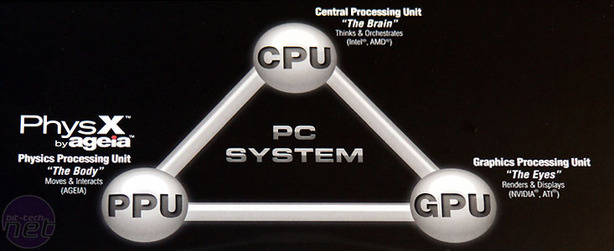The Future of PC Gaming... is here?
After months of promises and delays, AGEIA PhysX PPU retail cards are now available for consumers to buy, following the OEM launch with partners such as Dell and Alienware. Unlike ATI or NVIDIA graphics cards, which are typically available from at least half a dozen different partners, AGEIA enter the market with just two: ASUS, and BFG Technologies. The latter were the first to supply us with a shipping retail boxed hardware, the unit we are reviewing today.
Open the box already!


The box has been cleverly designed to echo the above triangle theory of CPU + GPU + PPU. BFG Tech joins XFX in the creative packaging department - everyone else just uses boring rectangles. Eye catching it may be, but this design is bound to give headaches to retailers and e-tailers alike, challenged with stacking these on shelves as well as shipping them to online customers.
BFG has opted for a somewhat meagre bundle, no doubt to keep costs down. It consists of a driver CD, a demo CD, a four-pin molex power splitter, a Quick Install Guide and a couple of case badge-like stickers. There are no full games bundled with the product.


The card is essentially an AGEIA reference design and is made from a sexy blue PCB, and sports 128MB of GDDR3 memory. Less sexy is BFG Tech's choice of cooler - a simple aluminium heatsink with a 45mm LED fan. While the latter projects a blue glow around the lower regions of your case, we would have hoped it was a little quieter in operation.
A Radeon X1900XTX will dwarf it when the fan spins up during heavy load in games like Oblivion, but in a system with a GeForce 7900 GTX at the heart, it adds a hint of unwanted whine. Playing games with headphones solves that in both cases, however the fact doesn't throttle down when the card isn't being used, meaning you're stuck with the noise even during general 2D use, long after your GPUs have switched to a near-silent running mode.


The card requires a standard 4-pin molex power connector - AGEIA tell us the 28W load is just on the high side of the maximum power draw capable through a PCI 2.2 expansion slot.. The result is yet another Y-cable, unless your PSU has an unused four-pin molex connector.
As strange as it may sound, handling the board messes with your head a little. Stop and think for a minute: when was the last time you saw an add-in board that had a blank backplate? A third-party RAID card perhaps, but almost anything else you can think of has some sort of port or connector on the back. In some ways, it reminds us of the original PowerVR 3D cards from the late Nineties which unlike their 3DFX rivals, also had no external connectors. It is a parallel that cropped up more than once in our testing.

MSI MPG Velox 100R Chassis Review
October 14 2021 | 15:04









Want to comment? Please log in.